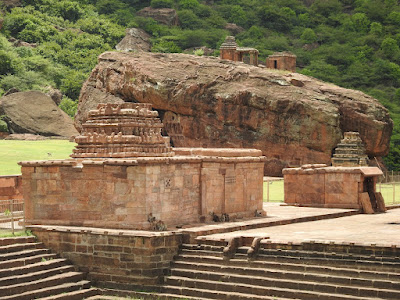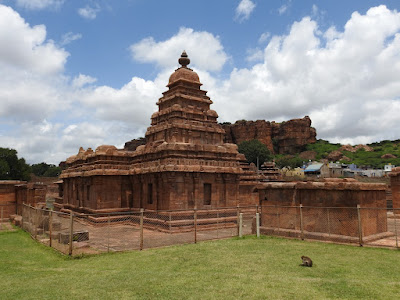Situated at one corner of Badami, Bhootnath group receives the least number of visitors. Of the tourists coming here, most are city folks or foreigners since the place is mostly free from hordes, most times it has a peaceful ambiance. The best part is the charm of the waterbody - Agastyatirtha. Then there are young couples looking for privacy find this place convenient.
This group consists of 8 temples including the small ones. The largest structure of the group is Bhootnath Gudi and other would be dedicated to other deities. Then there are a dozen or so relief sculptures on the huge boulder a stone's throw away. On the boulder are two small structures as well. I'm not sure if those rock-cut shrines and smaller temples are part of Bhootnath group. Totally there are 12 structural temples and more than a dozen rock-cut shrines.
I've visited this group three or four times, the memorable ones being in Sept 2012 and Aug 2023. During my earlier visit there were information boards which describe this monument as below.
ಭೂತನಾಥ ಸಂಕೀರ್ಣ
ಶ್ರೀ ಪೈಗರ ಶ್ರೀಧರ ಭೂತೇಶ್ವರ' ಎಂದು ಎಂಟನೆಯ ಶತಮಾನದ ಶಾಸನದಲ್ಲಿ ಉಲ್ಲೇಖಿತವಾದ ಭೂತನಾಥ ದೇವಾಲಯವು ಮುಖ್ಯವಾಗಿರುವ ಈ ದೇವಾಲಯಗಳ ಸಂಕೀರಣದಲ್ಲಿನ ಈ ದೇವಾಲಯ ಹಲವು ಬಾರಿ ಜೀರ್ಣೋದ್ದಾರಗೊಂಡಿದೆ. ಇದರ ಮುಂದಣ ಒಂದು ಶಾಸನದಲ್ಲಿ "ಕರಿಯಮ್ಮ ಸ್ಥಾನದ ದೀವಿಗೆ" ಎಂದಿದೆ. ಈ ಸಂಕಿರಣದ ಈಶಾನ್ಯಕ್ಕೆ ಒಂದು ರಾಷ್ಟ್ರಕೂಟರ ಕಾಲದ ಮಂದಿರವಿದ್ದು ಅದರಲ್ಲಿ ಲಕುಳೀಶನ 7 ಇಲ್ಲವೇ 8ನೆಯ ಶತಮಾನದ ಪೂಜಾ ಮೂರ್ತಿಯಿದೆ. ಇಲ್ಲಿ ಕಲ್ಯಾಣ ಚಾಳುಕ್ಯರ ಕಾಲದ ಹಲವು ಗುಡಿಗಳಿದೆ.
The Bhutanatha Group
This group has the main temple called 'Sri Paigara Shridhara Bhuteshwara' in a record of the eighth century. The temple has undergone repairs many times, and is a simple structure. An inscription in front speaks of "Kariyamma Sthanada Divige." There is a Rashtrakuta temple to its north-east with Lakulisha image within and the image is assigned to the 7th or 8th Century. There are many shrines of Kalyana Chalukya times around this.
The temples in this group are either west-facing or south-facing except one north-facing temple. The temple seen here in the background is the second largest here. In the background is the boulder with two temples on its top.
Turning our attention to the main cluster. The temples ate packed together leaving ample space around the cluster. As you see, this group of temples have access to the waters of Agstyatirtha. This waterbody is fed by the streams flowing down the sandstone hill.
When there's a good rainfall, a waterfall appears on the cliff. It's a sight to behold. This is the entrance to Bhootnath group. On the left is a special pillar, unsure of its purpose.
The first temple as we enter the cluster. This could be the Rastrukuta temple with an image of Lakulisha. Lakulisha is said to be the 28th and the avatar of Shiva. He is depicted with a lakut (mace) hence the name. Lakulisha is considered as the founder of the Pashupata sect and propounder of Yoga system.
Here's the idol of Lakulisha.
A smaller temple with a sloping canopy.
Rear view of the group. The well preserved Shikhara of Bhootnath temple seems to be a Vimananagari type. Shikhara of smaller temples are stepped pyramids. I feel these are experimental models like the temples of Galaganatha group at Aihole.
Rear diagonal view of Bhootnath Gudi. It's a beautiful structure with a wide pillared hall with two side entrances i.e. northern and southern sides.
At the southern entrance is a pillar similar to the one seen at the group entrance (fourth picture). At the first glance they look similar but with a small difference in the orientation of drilled holes . The pillar here seems to be a torch holder.
The side entrances are right next to the Antarala walls (vestibule). On the right hand side is a damaged sculpture. The reminder of the image is intriguing... what could that have been? Going by the looks of the interior, it seems this temple has been modified at least once. May be this hall was extended to accommodate more people.
Right opposite the Garbhagudi (sanctum) sits Nandi, and behind Nandi is a chamber which seems like a secondary sanctum. If it is another sanctum, we could call this temple a Dwikutachala.
A view of the packed space between the structures.
There goes Srinu my friend from Hyderabad. We were on a tour of the Chalukyan realm- Badami, Pattadakal and Aihole, Srinu's first visit here.
These small structures can be seen even at Pattadakal temple complex. In fact there are even smaller ones, 2" cubical temples. I feel these little structures were assignments or projects for apprentice sculptors.
Ancient builders planning was so careful, every little detail was looked into. Ancient temple sites rarely disrupted natural flow of rainwater around them. Same applies to Bhootnath group. The rainwater flows downhill forming a stream which joins Agstyatirtha right next to the group. On the left side of the picture is a small bridge, that's where the water flows in from. I really must visit here during a rainy season... wishing, hoping & praying for good rains this season.
Done with Bhootanath group of structural temples we move ahead to see the rock-cut shrines.
.........





























No comments:
Post a Comment